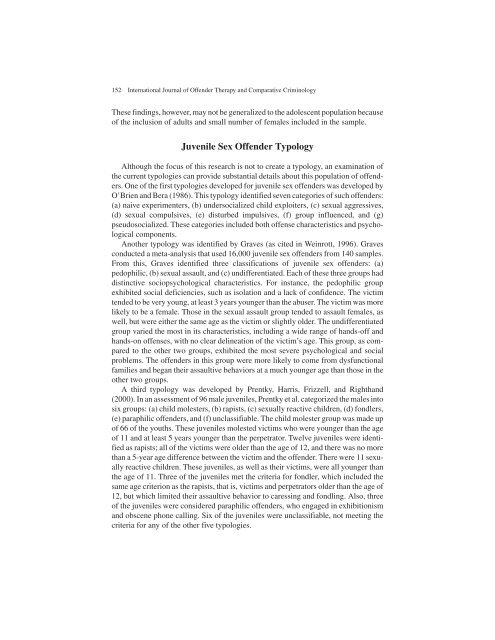Juvenile Female and Male Sex Offenders
Juvenile Female and Male Sex Offenders
Juvenile Female and Male Sex Offenders
You also want an ePaper? Increase the reach of your titles
YUMPU automatically turns print PDFs into web optimized ePapers that Google loves.
152 International Journal of Offender Therapy <strong>and</strong> Comparative CriminologyThese findings, however, may not be generalized to the adolescent population becauseof the inclusion of adults <strong>and</strong> small number of females included in the sample.<strong>Juvenile</strong> <strong>Sex</strong> Offender TypologyAlthough the focus of this research is not to create a typology, an examination ofthe current typologies can provide substantial details about this population of offenders.One of the first typologies developed for juvenile sex offenders was developed byO’Brien <strong>and</strong> Bera (1986). This typology identified seven categories of such offenders:(a) naive experimenters, (b) undersocialized child exploiters, (c) sexual aggressives,(d) sexual compulsives, (e) disturbed impulsives, (f) group influenced, <strong>and</strong> (g)pseudosocialized. These categories included both offense characteristics <strong>and</strong> psychologicalcomponents.Another typology was identified by Graves (as cited in Weinrott, 1996). Gravesconducted a meta-analysis that used 16,000 juvenile sex offenders from 140 samples.From this, Graves identified three classifications of juvenile sex offenders: (a)pedophilic, (b) sexual assault, <strong>and</strong> (c) undifferentiated. Each of these three groups haddistinctive sociopsychological characteristics. For instance, the pedophilic groupexhibited social deficiencies, such as isolation <strong>and</strong> a lack of confidence. The victimtended to be very young, at least 3 years younger than the abuser. The victim was morelikely to be a female. Those in the sexual assault group tended to assault females, aswell, but were either the same age as the victim or slightly older. The undifferentiatedgroup varied the most in its characteristics, including a wide range of h<strong>and</strong>s-off <strong>and</strong>h<strong>and</strong>s-on offenses, with no clear delineation of the victim’s age. This group, as comparedto the other two groups, exhibited the most severe psychological <strong>and</strong> socialproblems. The offenders in this group were more likely to come from dysfunctionalfamilies <strong>and</strong> began their assaultive behaviors at a much younger age than those in theother two groups.A third typology was developed by Prentky, Harris, Frizzell, <strong>and</strong> Righth<strong>and</strong>(2000). In an assessment of 96 male juveniles, Prentky et al. categorized the males intosix groups: (a) child molesters, (b) rapists, (c) sexually reactive children, (d) fondlers,(e) paraphilic offenders, <strong>and</strong> (f) unclassifiable. The child molester group was made upof 66 of the youths. These juveniles molested victims who were younger than the ageof 11 <strong>and</strong> at least 5 years younger than the perpetrator. Twelve juveniles were identifiedas rapists; all of the victims were older than the age of 12, <strong>and</strong> there was no morethan a 5-year age difference between the victim <strong>and</strong> the offender. There were11sexuallyreactive children. These juveniles, as well as their victims, were all younger thanthe age of 11. Three of the juveniles met the criteria for fondler, which included thesame age criterion as the rapists, that is, victims <strong>and</strong> perpetrators older than the age of12, but which limited their assaultive behavior to caressing <strong>and</strong> fondling. Also, threeof the juveniles were considered paraphilic offenders, who engaged in exhibitionism<strong>and</strong> obscene phone calling. Six of the juveniles were unclassifiable, not meeting thecriteria for any of the other five typologies.


